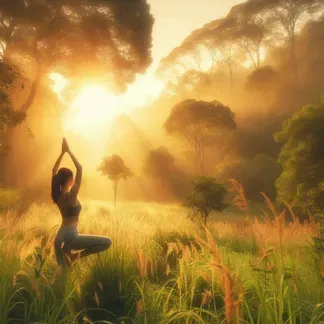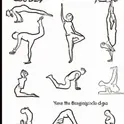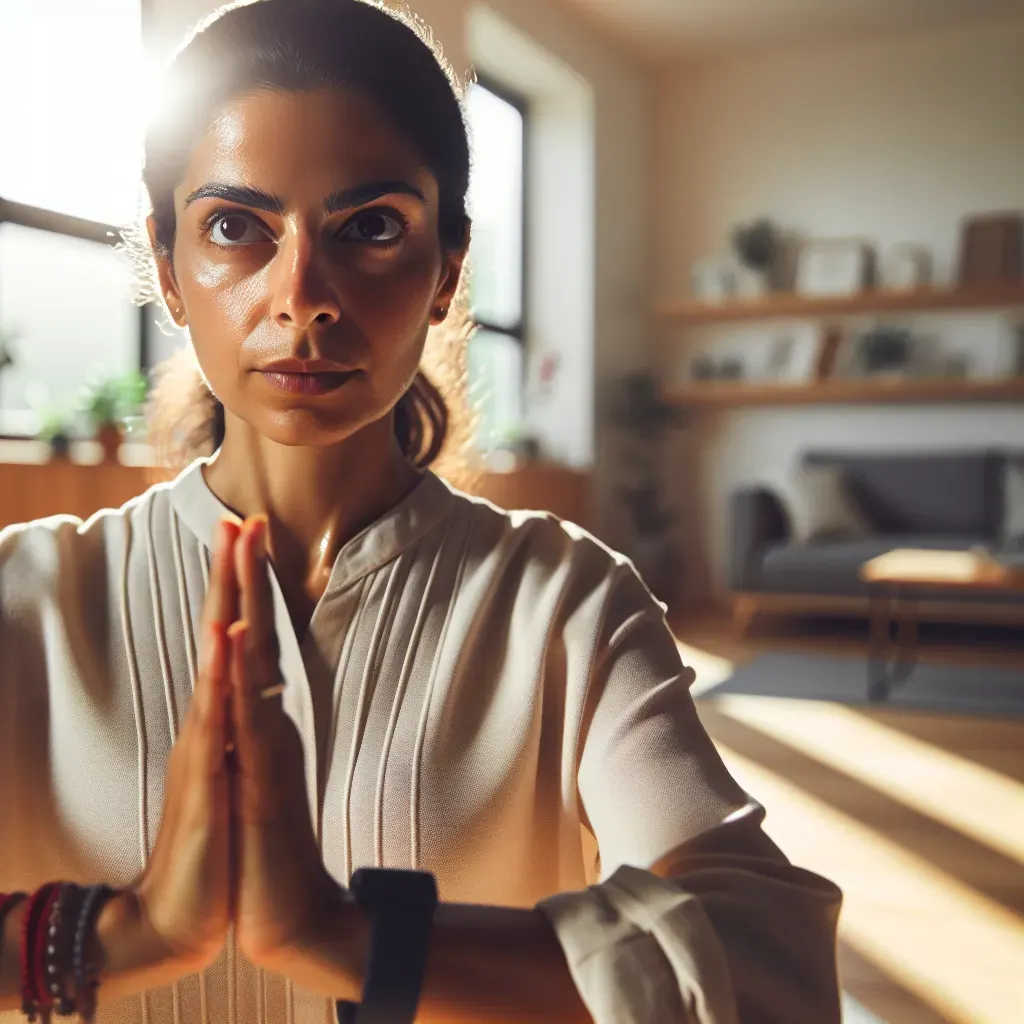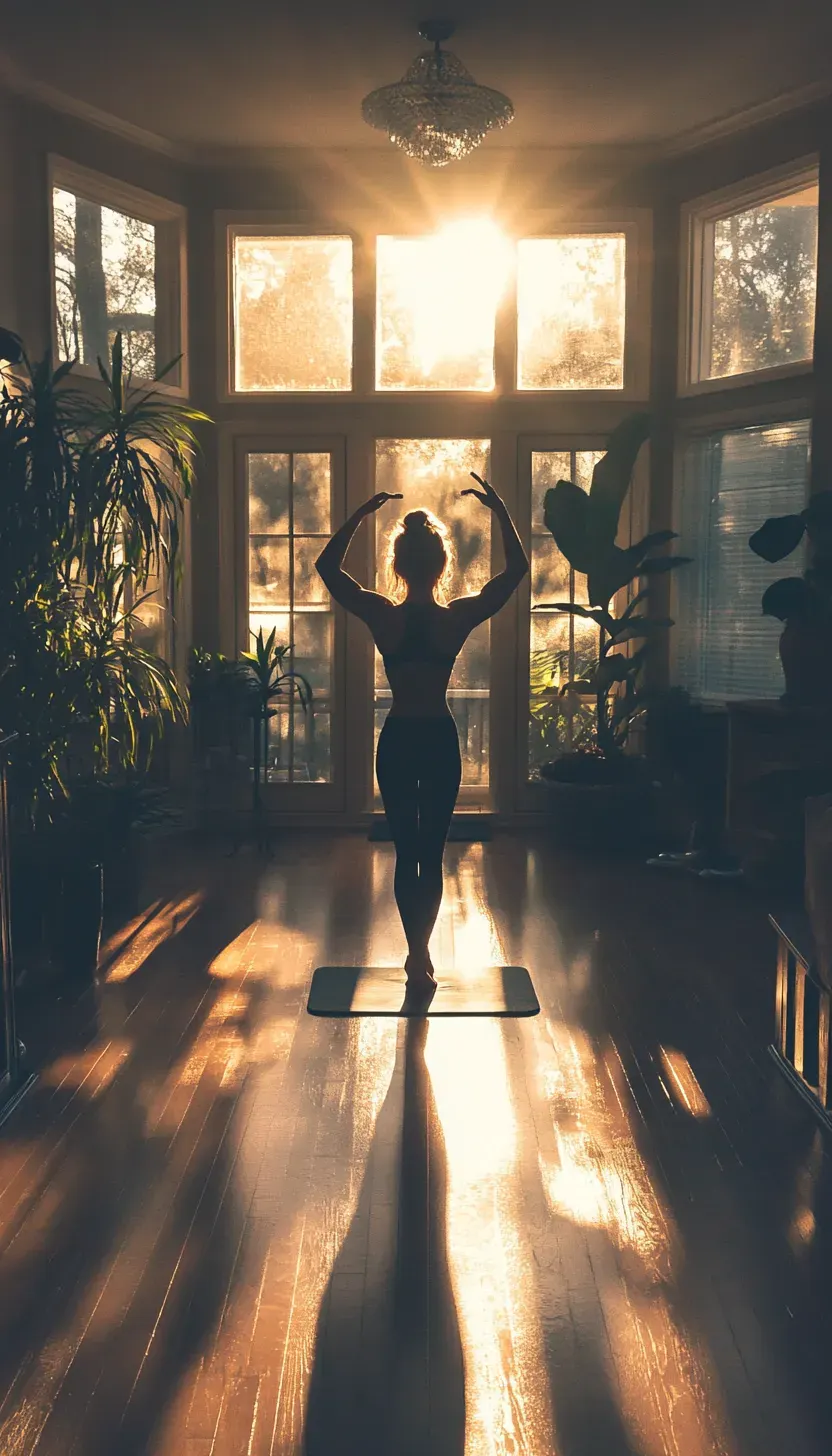Energized & Empowered: Transform Your Spirit With Dynamic Sequences
Table Of Contents
The Science Behind Dynamic Sequences
- Research on Emotional Well-Being
- Mindfulness and Movement
Benefits of Energized Practices
- Elevating Energy Levels
- Enhanced Focus and Mental Clarity
- Resilience to Stress
Transformative Journeys
- Sarah’s Story: Rediscovering Joy
- Jessica’s Story: Overcoming Anxiety
Integrating Dynamic Sequences into Your Routine
- Finding Time for Yoga
- Consistency and Routine
- Pairing Yoga with Daily Activities
Different Types of Dynamic Yoga Sequences
- Vinyasa Yoga
- Power Yoga
Overcoming Obstacles to Practice
- Time Constraints and Self-Doubt
- Strategies for Motivation and Consistency
- Community Engagement
Listening to Your Body: An Essential Aspect
- Adapting to Your Needs
- Emotional Feedback
- Practicing with Authenticity
Embrace Your Journey of Transformation
In a world that often feels chaotic and overwhelming, finding balance can seem like an elusive goal. Enter dynamic yoga sequences a transformative practice that weaves together movement and mindfulness to energize both body and spirit.
These flowing sequences not only awaken your physical strength but also nurture emotional resilience. Imagine a space where each breath guides you closer to clarity and empowerment, allowing you to release what no longer serves you while embracing your inner warrior.
For women especially, nurturing emotional well-being is essential. Life’s demands can pile up, leaving little room for self-care. However, prioritizing our mental health is crucial to thriving in all aspects of life. It’s time to reclaim that power through the gentle yet powerful embrace of dynamic sequences.
This article will guide you through the incredible benefits of these practices, show how they can elevate your spirit, and inspire you to incorporate them into your daily routine. Get ready to embark on a journey towards heightened energy and amplified joy your transformative path awaits!
The Science Behind Dynamic Sequences
Research increasingly shows that dynamic movement practices, such as yoga, significantly influence emotional well-being. A study published in the Journal of Clinical Psychology revealed that women engaging in regular physical activities, including dynamic yoga sequences, reported lower levels of anxiety and symptoms associated with depression.
This correlation can be attributed to how these movements stimulate the release of neurotransmitters known as endorphins.
These natural chemicals act like a natural painkiller and mood enhancer, creating what many refer to as the "yoga high." As you flow through a sequence moving gracefully from one pose to another your body not only engages physically but also catalyzes an internal release of positive emotions.
Beyond just endorphin release, dynamic sequences have been shown to engage both the body and mind in ways that traditional static forms may not. When performing a fluid series of poses, the participant is encouraged to focus on her breath and connection to each movement.
This mindfulness practice has been found to ground emotions while producing calming effects on the nervous system.
Research conducted at Harvard University highlighted that individuals who incorporate mindful physical activity into their routines report significant improvements in their overall happiness and life satisfaction scores compared to those who do less active forms of leisure.
The physiological mechanisms behind this transformation are equally compelling. Engaging in brisk movements activates adrenaline response systems that not only increase energy levels but also promote feelings of alertness and acuity.
Women practicing dynamic sequences often note enhancements in concentration and clarity post-session even during challenging days when stressors seem overwhelming.
Whether it’s energizing sun salutations or powerful hip-openers, these practices challenge our bodies while simultaneously instilling deep emotional resilience and vitality.
In essence, understanding the science behind these transformative practices empowers women not just physically but emotionally as well. The fusion of dynamic movement with mental focus creates a profound sense of balance crucial element for achieving sustainable emotional health.
Every time you step onto your mat for a session filled with vibrancy and flow, know that you're harnessing this powerful blend of mind-body synergy designed explicitly for enhancement not just fitness, but personal growth.
Benefits Of Energized Practices

Engaging in dynamic sequences can serve as a powerful catalyst for elevating your energy levels and vitality. Imagine starting your day with a Vinyasa flow, where each sun salutation invigorates your body and nourishes your spirit.
This practice not only gets the blood pumping but also activates various muscle groups, awakening every part of you. As women often juggle multiple responsibilities be it work, family, or personal projects finding ways to amplify energy naturally can be transformative.
Each session builds on itself; the more you practice, the more resilient and energetic you become, leading to improved productivity throughout your day.
In addition to physical benefits, dynamic yoga practices are deeply intertwined with enhanced focus and mental clarity. When you immerse yourself in these routines, the synchronization of breath and movement fosters mindfulness, pushing aside distractions that plague our busy minds.
The rhythm inherent in a Power Yoga session cultivates an environment where thoughts settle into silence, allowing you to harness heightened concentration a valuable asset in today’s fast-paced world.
Time spent on the mat becomes an investment not just in fitness but also in mental fortitude; women who prioritize this mindful engagement often find they can approach challenges with renewed perspective and creativity.
Finally, embracing energized practices grants greater resilience to stress. Women frequently face emotional overload from societal pressures or balancing numerous roles at once.
Dynamic sequences act as an outlet for processing those emotions; even a quick 15-minute routine can release pent-up tension while infusing positivity into your mindset.
It’s remarkable how rhythmically moving through poses allows emotions to surface without judgment something many may find difficult outside their yoga space.
By integrating this physical practice into daily life, emotional health flourishes alongside physical strength; thus transforming stress from an overwhelming foe into something manageable and less intimidating.
Ultimately, by prioritizing energizing yoga practices within your wellness journey, you're making strides toward holistic improvement: increased stamina shields against fatigue; sharpened focus enhances productivity; resilient spirits foster emotional stability.
Together these changes create a powerful vortex of well-being ready to unfold throughout every facet of life!
Transformative Journeys

The stories of women who have embraced dynamic sequences in their yoga practice paint a vivid tapestry of growth, resilience, and empowerment. Take Sarah, for instance. A busy mother of three, her life revolved around juggling family responsibilities.
She felt perpetually overwhelmed and disconnected from herself. Upon the recommendation of a friend, Sarah joined a vinyasa class that emphasized fluid movement and breath.
Over time, she began to notice not only an improvement in her physical strength but also a profound shift in her emotional state. The dynamic sequences helped her rediscover joy in movement, allowing her to process emotions that had long been buried beneath daily stressors.
Similarly, Jessica found solace through power yoga during a challenging period in her career. Struggling with anxiety and self-doubt after being passed over for a promotion, she approached yoga as a last-ditch effort for relief. Participating in high-energy classes transformed not just her body but also how she viewed challenges.
The fast-paced sequences mirrored life's ups and downs; each downward dog followed by upward flow reinforced Jessica's capacity to overcome obstacles both on and off the mat. “It became my therapy,” she shared, “not only did I gain physical strength; I learned mental fortitude.” Through consistent practice, Jessica cultivated resilience that empowered her to approach her work—and herself—with newfound confidence.
These testimonials underscore the idea that engaging in dynamic practices can lead to significant changes in emotional health and perceptions of self-worth.
Women like Sarah and Jessica are a testament to the powerful connection between movement and emotional release; they illustrate how embracing such energy-infused sequences can help one navigate life’s unpredictable terrain with grace and courage.
As they leaned into their practices more deeply, they unearthed layers of self-awareness previously veiled by everyday challenges—inspiring others along the way as they share their journeys toward transformation.
Ultimately, personal stories reveal that every woman has unique experiences related to movement—a reminder that incorporating dynamic sequences is not simply about fitness; it's about fostering emotional well-being too.
These transformative journeys do more than highlight individual successes they collectively encourage community support among women seeking holistic wellness through shared practice and mutual empowerment.
Integrating Dynamic Sequences Into Your Routine
Incorporating dynamic yoga sequences into a busy schedule can seem daunting, but it is entirely achievable with a little creativity and dedication. One simple strategy is to set aside just 15 minutes in the morning or midday for a quick session.
Can’t squeeze in an hour-long class? Consider following an online video or app that offers short routines specifically designed for busy individuals. Aim to find pockets of time throughout your day, such as before work or during lunch breaks, where you can engage in rejuvenating movements that make you feel more empowered.
Establishing a consistent practice doesn’t have to be overwhelming; small, incremental changes can lead to profound effects. Start with three sessions per week and gradually increase frequency as you become more comfortable integrating these sequences into your life.
A great goal is to aim for 20-30 minutes on each occasion. Consistency will not only provide physical benefits but will also enhance your mental clarity and emotional resilience over time, making it easier to handle life's demands effectively.
Another tip for integration is to pair dynamic sequences with daily activities, making them part of your existing routine rather than an added burden.
For instance, doing sun salutations while waiting for dinner to cook or practicing deep breathing exercises during your morning commute can create seamless transitions into mindfulness throughout your day.
Additionally, consider linking with a friend or joining a community group; having accountability partners can inspire commitment and enhance motivation.
Ultimately, remember that perfection isn’t the goal progress is! Listen closely to what your body needs on any given day; some days may call for vigorous movement while others might benefit from gentler flows.
By respecting your energy levels and adapting practices accordingly, you'll cultivate not only physical health but also emotional balance as you weave dynamic sequences into the fabric of your daily life.
Different Types Of Dynamic Yoga Sequences
When it comes to dynamic yoga sequences, two popular styles often stand out: Vinyasa and Power Yoga. While both approaches involve a fluid series of postures that link breath with movement, they do so in slightly different ways.
Vinyasa typically emphasizes smooth transitions between poses that flow in sync with inhalation and exhalation, creating a meditative rhythm.
This style not only enhances flexibility but also encourages mindfulness, making it ideal for those seeking a more balanced emotional state while still getting their heart rate up.
On the other hand, Power Yoga takes the intensity up a notch by incorporating stronger movements and positions designed to build strength and stamina. A sequence may include challenging postures like Chaturanga or Warrior variations held for longer durations, which push your limits and promote resilience.
This approach appeals particularly to fitness advocates who find empowerment in physical challenges and are looking to cultivate inner strength alongside physical prowess.
For beginners looking to dip their toes into dynamic practices, starting with a gentle Vinyasa flow can be incredibly rewarding. Simple sequences such as Sun Salutations offer foundational postures that develop body awareness without overwhelming the practitioner.
As individuals become more comfortable, they can gradually explore Power Yoga sequences that challenge both body and mind like the “Power Hour” class focused on core engagement through an energetic series of poses designed to uplift energy levels significantly.
Advanced practitioners might enjoy exploring hybrid sequences combining elements from both styles these allow experienced yogis to deepen their practice while fostering creativity in how they engage with each pose.
For example, alternating between intense power sequences followed by restorative Vinyasa flows can help balance exhaustion with rejuvenation, ensuring overall well-being.
Ultimately, understanding these variations enables every woman on her wellness journey to find the right dynamic sequence that resonates deeply with her spirit and energizes her daily life!
Overcoming Obstacles To Practice
Starting a yoga journey can feel daunting, especially for women who often juggle multiple responsibilities. Common barriers such as time constraints, self-doubt, or fear of not fitting into the perceived "yogi" mould can prevent many from stepping onto their mats.
For instance, a busy mother may struggle to find time amidst school drop-offs and household chores, while a professional woman might feel intimidated by the advanced practices showcased in social media feeds.
Recognizing these obstacles is the first step toward overcoming them.
To combat these challenges, it's essential to adopt strategies that foster motivation and consistency in practice.
Scheduling dedicated "me-time" into your calendar can be invaluable; just like any important meeting, treating your yoga session as non-negotiable helps prioritize self-care.
Setting achievable goals is another powerful tool rather than committing to an hour-long flow every day initially, start with 10-15 minutes of simple stretches or breathing exercises that fit seamlessly into your schedule.
This incremental approach builds confidence and makes it easier to integrate deeper sequences later on.
Another effective strategy involves community engagement. Joining a local class or an online group fosters connection and accountability among fellow practitioners who face similar hurdles.
Sharing experiences not only offers encouragement but can also illuminate new perspectives on overcoming personal barriers. Hearing uplifting stories from others on their paths often serves as a reminder that setbacks are natural; everyone faces struggles when beginning a new practice.
Lastly, cultivating patience and compassion towards yourself during this process is crucial. Yoga is inherently about growth and exploration; understanding that progress comes at different rates encourages you to embrace where you are now instead of how far you think you should have come by this point.
Approach each session with curiosity allowing space for feelings of joy or even frustration and see how each experience contributes uniquely to your wellness journey.
Listening To Your Body: An Essential Aspect
Engaging in dynamic sequences is a powerful way to revitalize both body and spirit, but perhaps the most critical element of this practice is the art of listening to your body. Each person's experience on the mat is unique, shaped by various factors like emotional state, physical condition, and everyday stressors.
Tuning into how you feel not only enhances your yoga practice but also nurtures your emotional well-being.
For instance, if you're feeling particularly stressed one day, it might be beneficial to focus on gentle stretches rather than full-power flows. Recognizing these emotions allows for a compassionate approach that respects what your body needs at any moment.
Adapting sequences based on personal comfort and energy levels doesn't mean surrendering your commitment to growth; instead, it's about honouring your journey. If a challenging pose frustrates you, consider modifying it with a gentler variation or eliminating it in that session.
This flexibility sparks empowerment as you affirm self-love over external performance pressures. For example, during an energizing Vinyasa class, if you find certain poses overwhelming, taking a child's pose can reset both mind and body while keeping you engaged in your breath—a potent reminder that yoga is ever-evolving.
Moreover, our bodies offer feedback beyond physical sensations; they resonate emotionally too. Perhaps you're flowing through sun salutations when suddenly an unexpected surge of emotion arises this is vital feedback signaling its importance in healing or releasing stagnation.
Use these moments as opportunities for self-reflection and awareness within your practice. Journaling post-session about how different rhythms of movement affected your mood can deepen this connection further and help customize future routines for optimal impact on both mental clarity and emotional stability.
Ultimately, prioritizing this dialogue between mind and body encourages authenticity within each practice session. Embrace the ebb and flow of varying energies day-to-day without judgment; every choice you make fosters resilience against life’s challenges while boosting overall wellness.
Remember that the journey towards empowered living is rich with insights gained from simply turning inward leading not only toward greater physical strength but also transformative emotional health along the way.
Embrace Your Journey Of Transformation
As you step into the world of dynamic sequences, remember that every small action contributes to your journey of holistic well-being. Embrace change with an open heart, knowing that each practice enriches your spirit and enhances your emotional health.
Start with one simple routine or a few mindful movements today. Allow yourself to evolve through these energetic practices.
Transformation doesn’t happen overnight, but it begins with a single choice. Each session on the mat cultivates resilience and ignites positive energy within you. Celebrate these incremental shifts; they lead to significant growth over time. Take this moment to commit to yourself and watch as you become empowered in body, mind, and spirit.
For more mind-body connections. Check out Unlock Your Mind And Body With Dynamic Sequencing
People Also Asked
What are dynamic yoga sequences?
Dynamic yoga sequences are flowing movements that combine postures with breath, enhancing physical strength and emotional resilience.
How do dynamic yoga sequences benefit emotional well-being?
They stimulate endorphin release, reduce anxiety, and promote mindfulness, leading to improved emotional health.
What is the difference between Vinyasa and Power Yoga?
Vinyasa focuses on smooth transitions and breath synchronization, while Power Yoga incorporates stronger movements for building strength and stamina.
Can dynamic yoga sequences improve mental clarity?
Yes, the synchronization of breath and movement fosters mindfulness and concentration, enhancing mental clarity.
How often should I practice dynamic yoga sequences?
Aim for at least three sessions per week, gradually increasing frequency as you become more comfortable.
What if I don’t have much time for yoga?
Even 15-minute sessions can be beneficial. Find pockets of time in your day, such as before work or during lunch breaks.
Is dynamic yoga suitable for beginners?
Yes, beginners can start with gentle Vinyasa flows and gradually progress to more challenging sequences.
How can I overcome self-doubt in my yoga practice?
Set achievable goals, engage with a community, and practice self-compassion. Remember that progress takes time.
Can dynamic yoga sequences help with stress relief?
Yes, they provide an outlet for processing emotions and releasing tension, promoting emotional resilience.
How do I listen to my body during yoga practice?
Tune into your physical and emotional sensations, adapting your practice to meet your needs each day.





